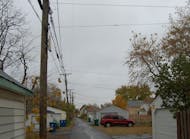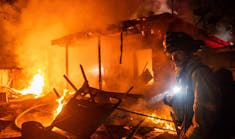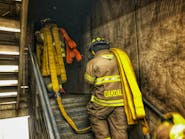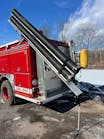Fire Scene: Using Outside Streams
An outside stream doesn’t have to be a master stream nor a 2½-inch handline.
Master streams are outside streams that deliver 300 gpm or more and can be a tower ladder stream, a portable deluge nozzle or an engine company deck pipe. They generally are used for fully involved structure and building fires, for the protection of exposures and sometimes for rapid knockdown of well-involved fires while interior lines are stretched and readied for entry into the premises.
Three options
Tower ladder streams are effective defensive outside streams that can be used offensively. A well-designed pipe on a tower ladder basket, when positioned right at a window and low, can be directed up to knock down the ceiling in that room and to open up and control fires in the cockloft, attic or truss loft that’s above that ceiling. Additionally, the heavy gpm and stream penetration will knock down fire in a larger area in much less time than an interior line can.
Portable deluge nozzles, which are located on the back step of many pumpers, can be very effective for exterior operations. Light and easily carried by a single firefighter, they often are reconnected to a supply line and placed into service as quickly as water can be supplied to them. Further, unlike older portable nozzles, they are designed so that they don’t have to be tied down for stability.
Engine company deck pipes are another master stream that can be very useful at structure and building fires. Often, they’re piped into the apparatus water system, so they aren’t removable from the rig. For that reason, their maneuverability is limited, though that doesn’t negate effectiveness.
The unique process that applies to deck pipes is that the position or location that the stream will be used from must be selected before the apparatus stops and goes into pumping. For this reason, officers and pumper chauffeurs must consider this as they approach a fire scene where the deck pipe might be required.
Another great benefit of deck pipes is that they can be used by the chauffeur while the pumper crew stretches a handline. This allows even a light crew to apply two water streams simultaneously.
Hoselines’ applicability
What other types of outside streams can we use? Can we use a 1¾-inch hoseline as an outside stream? Yes, but conditions and limitations should be considered.
Generally, we don’t select a small line, such as a 1¾- or 1½-inch line for extended exterior operations. For purely defensive applications, the 2½-inch line is and should be your first choice when sufficient water is available. What happens when sufficient water isn’t available? What can you do when you arrive at a well-involved private dwelling with a 300- or 400-gallon booster tank and more water is 10 or more minutes away?
Some of us might use the 1¾-inch line to stretch our supply for a few additional minutes. Rather than blasting the involved building with a 2½-inch line delivering 250 gpm, which will exhaust the tank water quickly, a 1¾-inch line, used sparingly and alternately on the fire building and exposures, extends the length of time that we might be able to operate before more water arrives.
Not pinned down
There are numerous different situations that can be handled in different ways using a variety of streams and appliances on the typical pumper. Keep your options open.

John J. Salka Jr. | Battalion Chief
JOHN J. SALKA JR., who is a Firehouse contributing editor, retired as a battalion chief with FDNY, serving as commander of the 18th battalion in the Bronx. Salka has instructed at several FDNY training programs, including the department’s Probationary Firefighters School, Captains Management Program and Battalion Chiefs Command Course. He conducts training programs at national and local conferences and has been recognized for his firefighter survival course, “Get Out Alive.” Salka co-authored the FDNY Engine Company Operations manual and wrote the book "First In, Last Out–Leadership Lessons From the New York Fire Department." He also operates Fire Command Training, which is a New York-based fire service training and consulting firm.






